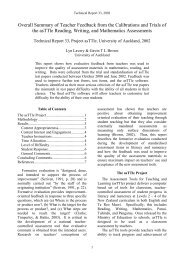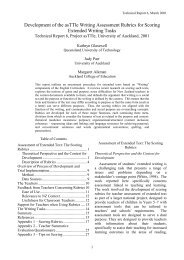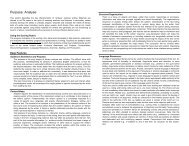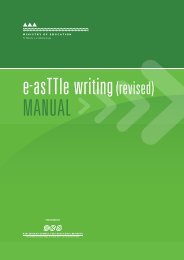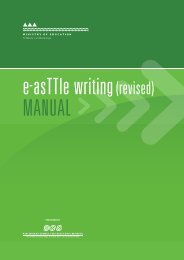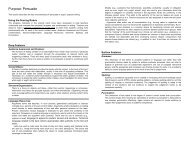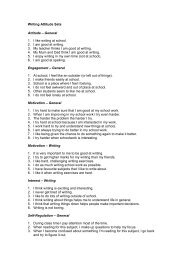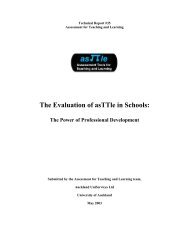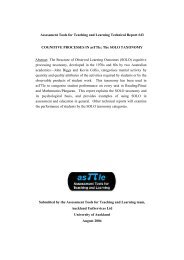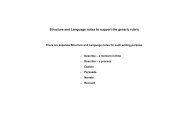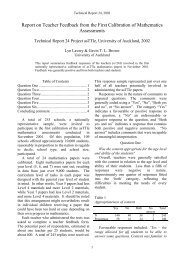11. Maths in the NZ curriculum 2001.pdf - e-asTTle - Te Kete Ipurangi
11. Maths in the NZ curriculum 2001.pdf - e-asTTle - Te Kete Ipurangi
11. Maths in the NZ curriculum 2001.pdf - e-asTTle - Te Kete Ipurangi
Create successful ePaper yourself
Turn your PDF publications into a flip-book with our unique Google optimized e-Paper software.
<strong>Te</strong>chnical Report 11: Mapp<strong>in</strong>g <strong>the</strong> Ma<strong>the</strong>matics Curriculum 9<br />
Table 1<br />
Probability objectives<br />
Compare events and order by likelihood (S L2-4)<br />
Use a systematic approach to count possible<br />
outcomes (S L3-5)<br />
Predict likelihood based on observations (S L3-6)<br />
Use tree diagrams to f<strong>in</strong>d all possible outcomes (S<br />
L4-9)<br />
Estimate frequencies and mark on a scale (S L4-8)<br />
For <strong>the</strong>se objectives, it is easy to observe<br />
children’s performance and categorise it by<br />
level. In response to a probability problem, a<br />
Level 3 child might draw a series of pictures to<br />
explore all of <strong>the</strong> possible outcomes, while a<br />
Level 4 child might use a tree diagram to f<strong>in</strong>d<br />
all <strong>the</strong> possible outcomes. The objectives are<br />
clearly head<strong>in</strong>g from <strong>the</strong> use of <strong>in</strong>formal<br />
discussion related to <strong>the</strong> child’s experience<br />
towards formal techniques for explor<strong>in</strong>g<br />
probability.<br />
In contrast, some objectives are very broad<br />
and ill-def<strong>in</strong>ed. The most significant of <strong>the</strong>se,<br />
because of <strong>the</strong>ir centrality to <strong>the</strong> development of<br />
children’s numeracy, are <strong>the</strong> write and solve<br />
objectives with<strong>in</strong> <strong>the</strong> number strand.<br />
Table 2<br />
Story problem objectives<br />
Write and solve story problems – with whole<br />
numbers<br />
– with 1 operation (N L2-10)<br />
– us<strong>in</strong>g any comb<strong>in</strong>ation (N L2-11)<br />
Write and solve story problems– with fractions –<br />
1/2s,1/3s,1/4s,1/5s (N L2-5)<br />
Write and solve story problems – with whole<br />
numbers and decimals<br />
– any comb<strong>in</strong>ation of operations (N L3-6)<br />
Write and solve story problems – with decimal<br />
multiplication and division (N L4-8)<br />
Although <strong>the</strong> parameters of <strong>the</strong> children’s<br />
problem solv<strong>in</strong>g are def<strong>in</strong>ed (<strong>the</strong> operations and<br />
types of numbers are given), <strong>the</strong>re is a huge<br />
amount of ma<strong>the</strong>matics implied by <strong>the</strong>se<br />
objectives. If <strong>the</strong>y are taken as written, <strong>the</strong>y<br />
mean that children at Level 2 should be able to<br />
write and solve problems <strong>in</strong>volv<strong>in</strong>g<br />
multiplication and division <strong>in</strong> comb<strong>in</strong>ation,<br />
us<strong>in</strong>g any whole number – no account is taken<br />
of <strong>the</strong> complexity of <strong>the</strong> calculation (e.g.,<br />
number of digits <strong>in</strong> <strong>the</strong> numbers). In practice,<br />
each teacher or school has def<strong>in</strong>ed what will be<br />
seen as competence with<strong>in</strong> <strong>the</strong>se objectives,<br />
potentially result<strong>in</strong>g <strong>in</strong> considerable variation<br />
between schools.<br />
The Level 3 and 4 objectives given <strong>in</strong> Table<br />
2 illustrate a fur<strong>the</strong>r difficulty. The Level 3<br />
objective implies that children should be able to<br />
do decimal multiplication and division, yet <strong>the</strong><br />
Level 4 objective specifies this as a Level 4<br />
skill. Aga<strong>in</strong>, f<strong>in</strong>d<strong>in</strong>g out where each of <strong>the</strong>se<br />
competencies sit <strong>in</strong> practice has been left to<br />
teachers to <strong>in</strong>terpret.<br />
Two-part objectives. Many of <strong>the</strong><br />
achievement objectives <strong>in</strong>clude two parts –<br />
write and solve, model and describe, for<br />
example. Each element of <strong>the</strong>se pairs is a<br />
separate activity, requir<strong>in</strong>g dist<strong>in</strong>ct skills.<br />
While <strong>the</strong>se paired objectives mirror one<br />
ano<strong>the</strong>r, solv<strong>in</strong>g a problem and writ<strong>in</strong>g a<br />
problem, for example, call on different sets of<br />
skills.<br />
The Content Map leaves <strong>the</strong> objectives<br />
<strong>in</strong>tact, fur<strong>the</strong>r broaden<strong>in</strong>g <strong>the</strong>ir scope. The<br />
Processes Map separates <strong>the</strong>se objectives <strong>in</strong>to<br />
implied activity categories, thus highlight<strong>in</strong>g<br />
<strong>the</strong> different competencies implied by each one.<br />
Aga<strong>in</strong>, us<strong>in</strong>g <strong>the</strong> Processes Map as an adjunct to<br />
<strong>the</strong> Content Map will give a fuller picture of <strong>the</strong><br />
implications of <strong>the</strong> <strong>curriculum</strong> document.<br />
Interconnectedness of concepts. Many of <strong>the</strong><br />
objectives that have been organised <strong>in</strong>to clusters<br />
<strong>in</strong> this analysis can be seen to “feed” one<br />
ano<strong>the</strong>r. Understand<strong>in</strong>g about <strong>the</strong> nature of<br />
shapes and <strong>the</strong>ir properties is necessary <strong>in</strong> order<br />
to understand how to calculate perimeter and<br />
area, for example. Similarly, understand<strong>in</strong>g <strong>the</strong><br />
base-10 place value system leads to a<br />
mean<strong>in</strong>gful understand<strong>in</strong>g of <strong>the</strong> metric system<br />
for measurement. And <strong>in</strong> order to sensibly<br />
<strong>in</strong>terpret graphs, a child needs to understand <strong>the</strong><br />
quantities represented and know how <strong>the</strong>se can<br />
be compared.<br />
While valid divisions can be def<strong>in</strong>ed with<strong>in</strong><br />
<strong>the</strong> ma<strong>the</strong>matics <strong>curriculum</strong>, children’s<br />
ma<strong>the</strong>matics understand<strong>in</strong>gs are built across<br />
<strong>the</strong>se categories. Ideally, concepts would be<br />
added to and applied across <strong>the</strong> <strong>curriculum</strong><br />
strands. As strands are often used as a basis for





